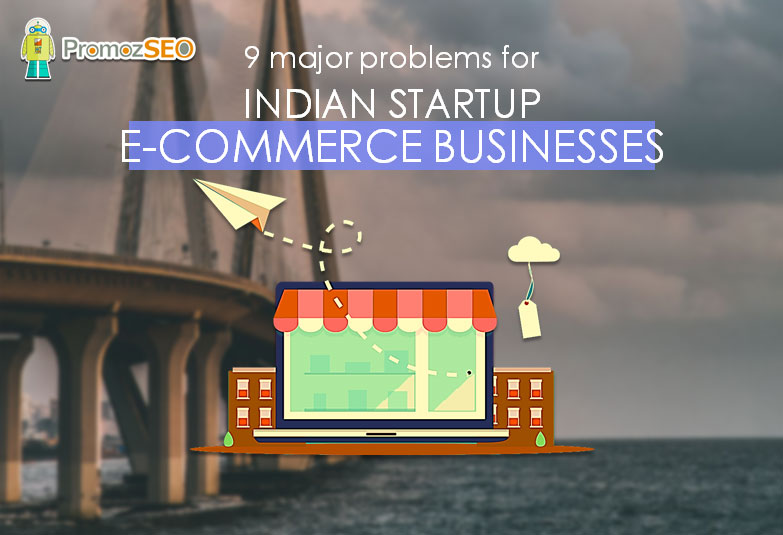9 Major Problems for Indian Startup E-Commerce Businesses

With the onset of the internet wave, people nowadays turn towards their smartphones first when they need to buy something. Online e-commerce websites have become the go-to places to buy a variety of items all under one roof. It’s convenient and hassle-free. And that is the main reason why there are so many e-commerce websites cropping up every day to cater to the masses throughout the world. Of course, India with an e-commerce market of 84 billion US dollar to touch by 2021, is no exception to that.
Now you may ask; if e-commerce business is all the rage right now, even in India then why there aren’t many successful ones rooted in India apart from the few biggies?
With a population of a staggering 1.2 billion, India is an attractive emerging market for retailers to reap extensive profits through e-commerce. In spite of that, except some popular e-commerce sites like Flipkart (Walmart acquired 77 percent controlling stake in Flipkart in 2018), Myntra, Snapdeal, etc., India is still lagging behind her western counterparts when it comes to the e-commerce business.
Again, the question arises – why?
There are several major issues that impede the success and smooth functioning of the e-commerce business in our country. And after driving a deep analysis we found a few burning factors that are causing the e-commerce companies facing the growth dead-locks.
So, without any further delay, let’s get right into them.
1. Internet Penetration is Low W.R.T India’s Overall Population
Digital literacy is a major problem for India. Out of the entire population, only 10% of the population is digitally literate enough to make their purchases on the internet. A huge bulk of the population still doesn’t know how to use the internet and moreover doesn’t have the means to buy stuff online.
Though India asserts itself as one of the largest growing economies in the world and by next 4 to 5 years down the line it is eying to become the 5 trillion dollar economy, the digital literacy rate is nowhere near the mark where businesses can earn projected profits in Indian digital market based on its sheer volume of population.
The ‘Digital India’ drive was launched by the Government of India in 2015 to digitally empower its citizens did not have much of an impact in rural India due to various challenges like the lack of infrastructure, personal computer penetration, and bandwidth availability to name a few.
Internet penetration in the Indian population is significantly low than other first world countries like the US or UK. Also, personal computers penetration is dismally low. With a big percentage of the Indian population still under poverty lines, computer and internet connections or even cell-phones for them is more of a luxury than a need.
Internet availability is another big factor. There are limited companies that provide high-speed internet and only present in urban cities. The internet has yet to spread to rural areas that encompass the majority of land space of India.
In many areas, the internet is available but through telephone lines which are mostly unreliable and does not provide enough bandwidth for high-speed transactions. Internet connection is still not cheap or readily available to a huge mass of the population which acts as the real roadblock for the success of e-commerce businesses in India.
However, as India is one of the fastest-growing economies in the world, it will certainly overcome these deadlocks by encouraging startups, giving them the right kind of infrastructure, mentorship, and funding opportunities. A few programs like National Digital Literacy Mission (NDLM) has been started to literate and empower at least one person per household in India by 2020.
2. High Competition from Big E-commerce Giants
Companies with deep pockets like Amazon, eBay, and Walmart have made headway in the Indian e-commerce market because they have the funds to overcome the various logistical challenges present for this business in India.
They have already established an authority not only through their service but through their marketing and reputation as successful businesses abroad. That makes them a formidable opponent from the get-go.
In such situations, new budding e-commerce companies have a difficult time to thrive on their own while turning profits. In most cases either they are not heard of after a few years or are acquired by conglomerates like Amazon or Walmart and turned into a part of their operation.
The giants like Amazon, eBay, or Flipkart have a better reach towards customers as well as provide them with quality products from a varied range with whopping discounts and cash-backs, which for a big organization like them could be child’s play, but is difficult for a new company with limited seed capital to achieve and execute.
Until and unless small e-commerce businesses have unique and ‘out of the box’ products to sell and have the backing of some big-wig indigenous organization and Government, competing and surviving in the Indian market is tough.
3. Trust and Fear Factor
The majority of the Indian buyer demographic relies on their purchases after physically checking the products to assure their quality. As they cannot do that through the internet, their trust level goes way down while purchasing items online.
They are wary of the products that are available in the e-commerce websites and generally don’t trust to make a big amount purchase due to their fear of the unknown. Though Amazon, Flipkart, Snapdeal, Myntra, and Jabong (parent organization Myntra) have been able to overcome these hurdles through their brand awareness and marketing, small and lesser-known e-commerce businesses are not that successful in this front.
Apart from the trust or the lack of trust issue, another anxiety that persists in Indian buyers’ psyche is the fear of online frauds and insecure online money transactions. They are not comfortable in sharing their debit card, credit card, and net banking details online in fear of getting duped and robbed of their hard-earned money. After a slew of such frauds being carried out even to this day, who can really blame them.
Though online security has been improved significantly across many e-commerce business platforms, Indian buyers are still skeptical of making a purchase online especially if they can get the same product in the brick and mortar shops near or far their homes.
4. Cash on Delivery (Collect on Delivery) Model
To overcome the problem of internet fraud, e-commerce businesses generally opt for cash on delivery (COD) model, wherein the customers need to pay for the product at the time of the delivery. It may sound amazing and a great tactic but it has its fair share of disadvantages.
The foremost being the refusal of payment by customers on receiving the product. This leads to a huge loss to be incurred by companies. Also, there is a problem of intentionally posting the wrong address while placing an order which again results in terrific losses.
After shouldering the prices of product transit, the ultimate non-sale of the product leads o potential loss in sales and revenues. This results in big-time losses for e-commerce giants, so just imagine the condition of small e-commerce companies.
5. Not Focusing on Micro-Niche Segments
We all know that picking a niche and sticking to it is far more effective in running a successful business than being a jack of all trades. Out of a niche, picking a micro-niche and cultivating it for better lead generation and sales is highly profitable if done right.
Take clothing for example. It’s a niche whereas traditional clothing is a micro-niche which can have many other micro-micro-niches in it as well.
Most of the e-commerce businesses don’t tap into their micro-niche potential enough. They market their goods over a broad range of products that may give them a bigger customer net but lesser conversions compared to other businesses that focus on micro-niches.
One great example of one such e-commerce business in India, which focuses on micro-niche is TheSouledStore.com. It’s basically an apparel selling site with their micro-niche being fandoms. They create clothing and other accessories completely based on fandoms and other quirky and trendy themes. In this way, they are catering to a very specific group of customers which is more of an advantage than a disadvantage to them given their popularity.
6. Pricing and Discount Challenges from Big E-commerce Companies
Big-wigs like Amazon and Flipkart are tough competitors in every way to new e-commerce businesses especially when it comes to pricing and discounts.
The benefits that these e-commerce giants can provide to their consumers in the form of reduced pricing, huge discounts, and frequent sales is a massive attraction for Indian customers to buy from them rather than purchasing from other e-commerce businesses without such facilities.
With the added bonus of free delivery system and one-day delivery systems that big e-commerce companies can provide to their customers due to their much-advanced logistics and in-house transportation networks, they are the king in the e-commerce business and very difficult to compete against.
7. Lack of Proper Knowledge and Poor Market Research
Most e-commerce ventures in India fizzle out after a few months or years of being online due to their lack of proper planning with regards to the products they are selling or due to poor knowledge of their chosen products’ market and customers.
Not enough preparation in the form of research, market analysis, customer profile analysis or lack-luster exposure is sure to drive any business to its knees.
So doing an extensive analysis on selecting a unique product line with a higher profit curve and attracting customers who are more likely to buy the product should be the first and foremost level of execution when launching an e-commerce business in India.
India is a multi-cultural country so the range of products that can be marketed and sold online are numerous. Depending upon the demand or unavailability of a unique product, an e-commerce business can make big bank in the Indian market despite the challenges present.
8. Lack of Internet Marketing Know-How As Well As Budget for Execution
Internet marketing is a powerful tool in the digital market to create a brand that consumers are aware of as well as trust to make a purchase from. Most of the start-ups do not put enough stress on this aspect. Either they don’t know how or don’t have the budget to hire people to do it for them.
This one drawback alone can cost newly emerging e-commerce companies a big time and downturn their brand value or in other words, profits and recognition. Even if an e-commerce company has a product that consumers love and want, they cannot be successful if the said consumers don’t know that they are selling them.
With internet-based advertising having higher viewership and conversions than the traditional form of advertising methods, internet marketing should be made a priority for any e-commerce company in India to succeed.
Traditional TV viewership continues to fall among every major demographic between the ages of 2 and 49, according to Nielsen’s Q3 2016 Total Audience Report.
~ Business Insider, Jan 4, 2017
The more number of eyeballs you can attract online to your e-commerce business, the more brand awareness you will acquire and thus confirms more visits and higher conversions. And for achieving this an efficient e-commerce internet marketing strategy is a must.
9. Poor Infrastructure and Inefficient Management of Resources
Even after getting all of their ducks in a row, many e-commerce businesses in India fail to stand out and succeed due to inefficient management of their resources. Either they have human resource management issues, inefficient customer care service, or they are unable to provide the quality product that they have promised to their consumers.
Another result of poor infrastructure is a delay in delivery of a product which is always a deal-killer for every customer. Once they encounter this specific problem, they won’t be likely to make a purchase again from that e-commerce website.
In all the above scenarios, consumers are likely to lose their trust fast in that brand. And once the word is out that your brand is less reliable and not consumer-friendly, your brand value will decrease overnight which will naturally affect sales and overall permanence and sustainability of your e-commerce business.
Over to You
The challenges are overwhelming when doing e-commerce business in India but there are many businesses that have started up and are now thriving despite all of those constraints.
This article is in no way a means to discourage budding e-commerce businesses to try their luck in the Indian market. But it is more of a guideline of what to look out for and be prepared for while conducting their online stores.
Indian e-commerce businesses like AlmaMater, Bewakoof are successful today in spite of all the challenges that are listed in this article. So, if they can, why can’t you?
Every venture has its disadvantages in one way or another. It is the ability to overcome them that sets a particular business apart and makes them successful.
Please let us know your experiences in your e-commerce business venture and what are the challenges that you have faced while conducting them in India. We and our readers would very much like to know. Signing off!
An advanced All-in-One Digital Marketing Course.
Mentored by Mr. Soumya Roy, the Founder, CEO of PromozSEO Web Marketing Academy.
- Reasons Your Business Needs to be on Instagram - September 16, 2021
- 7 Reasons Your Business Should Invest in Professional Content Creation - August 12, 2021
- 5 Ways You Can Improve Your Website’s Existing Backlinks - April 30, 2021






2 Responses
Good content, thanks for sharing your valuable information.
Thanks for stopping by. Glad you liked it.
Comments are closed.